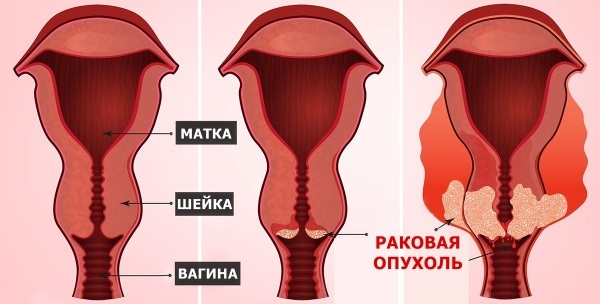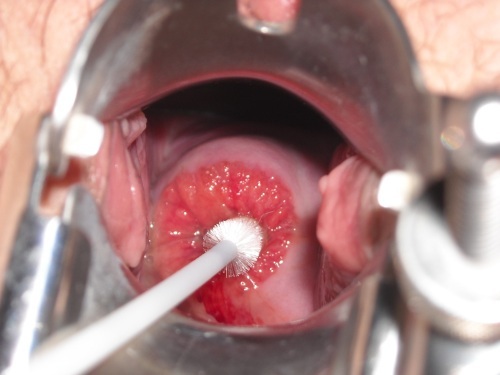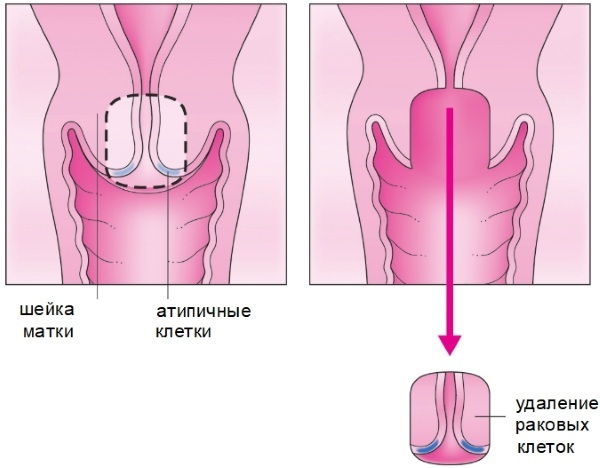Squamous cell carcinoma affects the cervix. Cancer cells begin to grow and multiply on the surface of her tissues. The degeneration of healthy cells occurs under the influence of provoking factors. In 90% of cases, the doctor diagnoses exactly squamous cell carcinoma of the cervix among all oncological lesions.
It is important to go to the hospital in a timely manner, undergo a complete medical examination and start a specially selected therapy. In some situations, progressive malignant processes entail fatal complications.
Record content:
- 1 Views
- 2 Stages and degrees
- 3 Symptoms
- 4 Reasons for the appearance
- 5 Diagnostics
- 6 When to see a doctor
- 7 Prophylaxis
-
8 Treatment methods
- 8.1 Medications
- 8.2 Traditional methods
- 8.3 Other methods
- 9 Possible complications
- 10 Cervical Cancer Videos
Views
Given the various criteria, squamous cell carcinoma of the cervix is classified according to the following types:
| Name | Description |
| Histological structure |
|
| Growth direction |
|
| The nature of the invasion |
|

Atypical cancer cells are characterized by rapid growth and reproduction. They can infect not only the upper layer of the cervical epithelium, but also penetrate into the glandular layers of healthy tissues. Malignant cells consume and replace them.
Stages and degrees
Any malignant process proceeds in stages. At each stage, characteristic symptoms appear, with which you should consult a doctor for examination and initiation of therapy.
Squamous cell carcinoma of the cervix goes through the following stages:
| Name | Description |
| Transitional stage | Healthy cells of the cervix mutate, but the malignant neoplasm is still absent. The stage is called interepithelial neoplasia. The changed cells cover the upper layer of the cervix. |
| First stage | Atypical cells grow, and an oncological focus is formed. The size of a malignant tumor is up to 4 cm. The mucous membrane of the cervix is affected. Pathological processes penetrate deep into the affected tissue layers. There are no metastases. Timely therapy in 95% of cases allows you to completely get rid of mutating cells and restore fertility. |
| Second stage | Malignant processes penetrate into the uterine cavity, affect the deep layers of the organ. The tissues of the vagina and pelvic organs remain unharmed for now. There are no metastases, the lymph nodes are normal. |
| Third stage | Progressive malignant processes provoke the appearance of the first metastases in the lymphatic system. The tissues of the vagina, organs of the genitourinary system and small pelvis are affected. In 35% women survive and recover. |
| Fourth stage (thermal) | An advanced stage of the disease, when not only the pelvic organs, vaginal tissues, but also distant organs are affected. Metastases appear, which disrupt the functioning of the systems of the human body. At the thermal stage, 5% of patients with squamous cell carcinoma of the cervix survive. |

At the first stage, the woman is more likely to be completely cured. Detection of pathology at later stages, in some cases, leads to death. Therefore, it is necessary to start treatment in a timely manner and remember about prevention.
Symptoms
Squamous cell carcinoma of the cervix in most cases is accompanied by characteristic symptoms. Signs of malignant tissue degeneration are absent in the early stages. The first manifestations disturb the woman at the onset of the later stages of the development of squamous cell carcinoma.
| Name | Description |
| Painful sensations | The intensity and nature of the pain syndrome depends on the stage of development of the disease. At first, there are mild periodic painful sensations. Then they grow and acquire a permanent, pronounced character. |
| Swelling of the lower extremities and genitals | Malignant processes provoke the spread of metastases throughout the human body through the circulatory system and lymph nodes. The outflow of fluid is impaired, as a result of which the legs and organs of the reproductive system swell. |
| Purulent or bloody discharge | A pungent and unpleasant odor appears. |
| Chronic fatigue syndrome | Even after a long rest, the woman feels exhausted. |
| Decreased appetite | Pathological processes disrupt the functioning of the body, so a woman forces herself to eat, even without feeling hungry. |
| Body temperature rises | A slight rise in body temperature is accompanied by chills. |
If any signs of squamous cell carcinoma appear, it is important to consult a gynecologist in a timely manner. The specialist will conduct an examination and schedule a consultation with an oncologist. The therapy is carried out using complex methods after a complete medical diagnosis.
Reasons for the appearance
Scientists have not fully studied the mechanism of the appearance of malignant cells, however, there are numerous provoking factors, which contribute to the occurrence of pathological processes:

| Name | Description |
| Bad habits | This applies to active and passive smoking. Tobacco smoke is carcinogenic. |
| Immunity impairment | A decrease in the defenses in a woman's body, hormonal changes contribute to the development of numerous diseases, including squamous cell carcinoma of the cervix. |
| Early onset of sexual activity | Sexual intercourse at an early age injures the tissues of the cervix and provokes the appearance of pseudo-erosion. The risk of degeneration of damaged cells increases. |
| Promiscuous sex | A complex of sexually transmitted infections increases the risk of developing squamous cell carcinoma of the cervix. |
| Lack of hygiene | The increased accumulation of secretions of the sebaceous glands creates a favorable environment for substances that contribute to the emergence of cancer cells. |
| Benign neoplasms | Erosion, ectopia, pseudo-erosion, leukoplakia and polyps in the cervical region provoke the appearance of malignant processes. |

Pathological factors also include malnutrition, age-related changes in the body, long-term use of complex oral contraceptives.
The same applies to frequent surgical interventions on the organs of the female reproductive system, severe stress, chronic inflammatory diseases. Hereditary predisposition also increases the risk of cervical squamous cell carcinoma.
Diagnostics
An oncologist will help to establish an accurate diagnosis. The specialist will prescribe a medical diagnosis and, based on the results obtained, select the most effective treatment.
With squamous cell carcinoma of the cervix, a woman is prescribed the following diagnostic measures:
| Name | Description |
| Biochemical and general blood test | The general condition of the female body is assessed, and special tumor markers are determined. |
| Biopsy | The material taken will make it possible to determine the nature of the origin of malignant cells. |
| Pap test | The material for research is taken with a special tool - a gynecological spatula. The affected tissue is sent for histological examination. |
| Histological tests | Laboratory examinations of cells, which make it possible to establish the cytological picture of the disease. |

Diagnostics is necessary for the timely detection of pathological processes, determining the degree and severity of the malignant course of the disease.
When to see a doctor
It is necessary to consult a doctor as soon as the first symptoms of pathological changes appear. But it is better to constantly undergo prophylaxis, which will allow detecting malignant cells in the early stages of carcinoma development. In this situation, a woman has more chances to fully recover and plan the birth of a child in the future.
Detection of a disease in the late stages of development does not guarantee a complete healing. In the most difficult situations, doctors try to improve the quality of a woman's life, otherwise they are powerless.
Prophylaxis
You can prevent the appearance of squamous cell carcinoma of the cervix, just remember the useful recommendations of an oncologist and gynecologist:
- Visit a specialist for preventive purposes once a year and undergo the necessary diagnostic measures.
- Timely treat various infectious diseases that are sexually transmitted.
- The gynecologist recommends refusing to take long-term combined oral contraceptives. The drugs are used for no more than 5 years.
- Monitor hormone levels. Take tests to monitor changes.
- If the doctor diagnosed erosion, polyps or leukoplakia, it is necessary to undergo colposcopy to exclude the development of malignant processes.
- Observe a regular sex life, give preference to one partner.
- Use protective equipment during sexual intercourse.

- Adhere to simple rules of personal hygiene.
- Quit smoking and alcohol abuse.
- Strengthen and temper immunity.
Modern medicine also offers specific prevention of squamous cell carcinoma of the cervix, which involves vaccination. It is carried out in adolescence after consultation with a gynecologist.
Treatment methods
The therapy is selected by the physician after a complete and thorough medical examination. It is necessary to determine the severity of the malignant processes. Treatment methods are selected taking into account the characteristics of the disease and the woman's condition. It is important not only to eliminate malignant foci, but also to restore the reproductive functions of the female body.
Medications
Squamous cell carcinoma of the cervix is treated with medication in the early stages of development, when healthy cells are just beginning to mutate.
The patient is prescribed the following drugs:
| Name | Application | Contraindications |
| Cisplatin | The drug is administered intravenously at 50-100 mg / m2 every 3-4 weeks. |
|
| Doxorubicin | The adult dosage is 60-90 mg / sq. m. The drug is administered intravenously every 3-4 weeks. |
|
| Carboplatin | The drug is administered intravenously, pre-diluted with glucose or sodium chloride. The recommended dosage is 400 mg / sq. m every 4 weeks. |
|
Medicines should be strictly taken as directed by a doctor, since they contain toxic components that affect healthy cells in the body.
Traditional methods
Prescriptions of healers and healers will not help completely get rid of a malignant tumor. Traditional medicine can reduce the negative manifestation of cancer processes, improve the patient's condition and increase the body's defenses.
Recommended folk remedies:
| Name | Recipe | Application |
| Celandine root | Rinse the root, dry well and chop, squeeze out the juice. Mix 500 ml of juice with vodka (0.5 l) and leave for 21 days, periodically shake the resulting mass. | The medicine is recommended to be taken 1 drop at a time, after diluting it in 0.5 tbsp. water. Every day, increase the amount of medicine by 1 drop. The course of treatment lasts 25 days. |
| Hemlock oil | Mix 200 g hemlock seeds and omega herb. Add 0.5 l of vegetable oil. Close the container well and leave for 21 days in a dark place. Shake the mass every day. Strain and use for tampons. | It is recommended to put tampons previously soaked in hemlock oil every day before going to bed for 60-90 days. |
| Wormwood | Pour the herb (2 tablespoons) with cool boiled water (200 ml). Close the container and leave for 10 hours. Put the resulting mass on fire and boil for 10 minutes. Cool for 2 hours and drain. | The finished product is used for douching in a warm form. |

Prescriptions should be used after consulting an oncologist. Many components of folk remedies can provoke an allergic reaction or worsen a health condition. It is important to take into account contraindications and remember about individual sensitivity.
Other methods
Squamous cell carcinoma of the cervix in complex therapy involves adherence to a certain diet.
| Featured Products | Prohibited foods |
|
|
A balanced and varied diet will help increase the body's defenses, strengthen the immune system, and alleviate the symptoms of the disease. Also improve the general well-being of the patient and eliminate acute intoxication of the body.
In most cases of cervical carcinoma, surgical treatment is used:
| Name | Description |
| Conization of the cervix | After partial resection, the surgeon removes the contents of the cervical canal. If necessary, the uterine cavity is also cleaned. The removed affected tissues are sent for histology. |
| Trachelectomy | The operation involves the complete removal of the cervix and the upper part of the vagina. Trachelectomy is performed if the tumor is 2 cm maximum. The operation allows you to preserve the reproductive functions of the female body. |
| Extirpation | Surgical treatment is indicated for tumors up to 4 cm in size. During the operation, the uterus, the upper part of the vagina, the cervix and the appendages are removed. |

Chemotherapy or radiation therapy is used in combination with surgical methods:
- Remote. The radiation source is at a certain distance.
- Contact. The radiation source is introduced into the organs of the reproductive system.
After surgery, patients are recommended to undergo radiation treatment for 2 months in order to prevent repeated relapses of the disease.
Possible complications
In the absence of timely therapy, squamous cell carcinoma of the cervix provokes serious consequences:
| Name | Description |
| Genitourinary system | A malignant tumor grows and puts pressure on the bladder and ureter, disrupting their functioning. Stagnation of urine, difficulty in its excretion provokes the development of inflammatory and purulent processes. The woman complains of strong painful sensations, and the body temperature also rises. |
| Liver | When malignant carcinoma disintegrates, it releases a large amount of toxins that the liver cannot cope with, and its functional abilities are impaired. |
| Kidney | A malignant tumor provokes the appearance of metastases that affect the renal pelvis. Fistulas form in the area of the tubules. Against the background of pathological changes, renal failure develops. |
| Metastases | In the early stages of the disease, tumor formation occurs. Regional lymph nodes are affected. As squamous cell carcinoma progresses, malignant cells spread through the blood and lymph throughout the body. As a result, secondary neoplasms appear. |
In some situations (30%), despite the full and comprehensive treatment, there are repeated recurrences of squamous cell carcinoma. The prognosis for the future depends on numerous factors, including the individual condition of the patient and how quickly she sought help.
Squamous cell carcinoma affects the tissues of the cervix and is accompanied by characteristic symptoms. The disease can be prevented by visiting a gynecologist for preventive purposes, and remembering the helpful recommendations of a specialist. When malignant processes are detected, it is important to immediately start treatment, since the likelihood of death is high.
Article design: Vladimir the Great
Cervical Cancer Videos
About cervical cancer:





